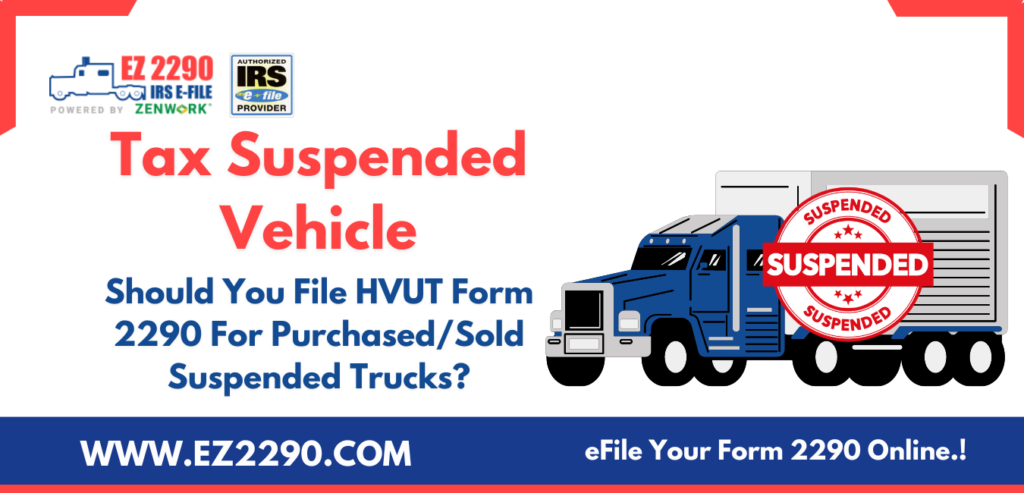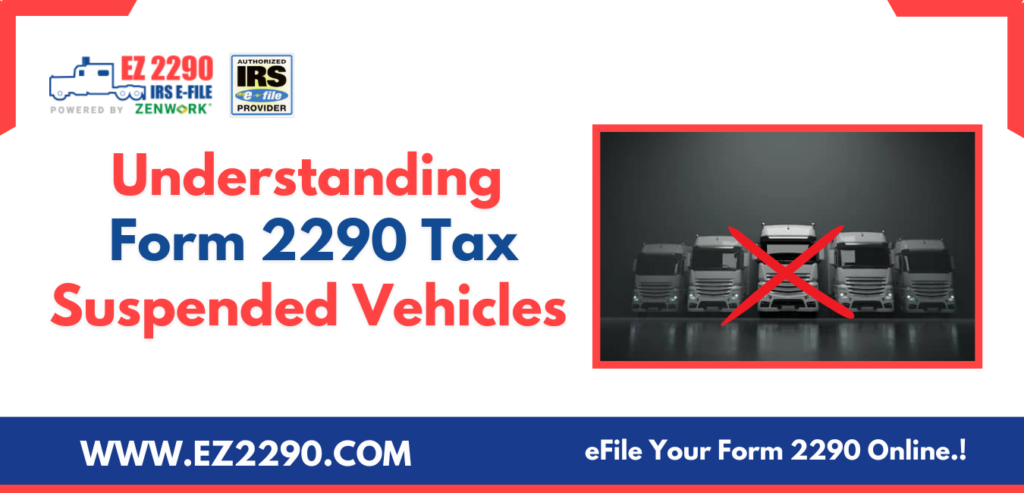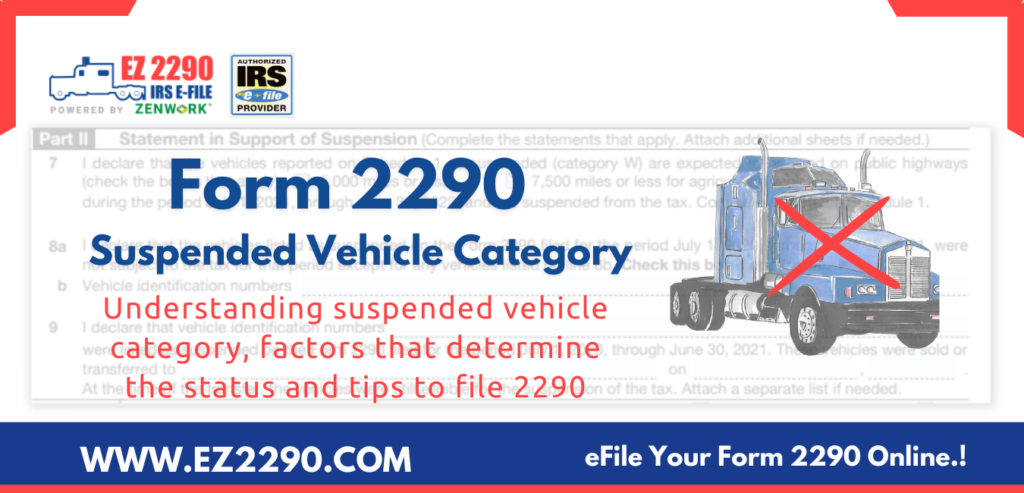
What to do when your vehicle has less than the HVUT-qualifying mileage limit? And what do you do when you buy/sell a tax-suspended vehicle? Learn all about reporting suspended vehicle information in this guide.
Understanding HVUT Vehicles
Vehicles that qualify for heavy highway vehicle usage tax are known as HVUT vehicles. You will need to file a HVUT 2290 form to report the vehicle information.
Trucks, semi-trailers, and other types of heavy vehicles that operate on the highways, weighing 55,000 pounds or more, are taxed according to their taxable gross weight.
The month in which the vehicle was first used is also considered when calculating the 2290 tax.
When vehicles meet or exceed the mileage use limit of 5000 miles (for regular vehicles) and 7500 miles (for agricultural vehicles), they are taxable under the HVUT tax rules.
However, as long as the vehicles remain within these limits, they’re not taxed. Hence, such vehicles are known as tax “suspended” vehicles.
Just remember that suspended vehicles are Category W vehicles. They’re only suspended from taxes, but not exempt from HVUT filing.
Vehicle owners still need to file their 2290 forms and report the tax suspension details of the vehicles on the HVUT returns.
Should You File HVUT Form 2290 For Suspended Trucks?
Yes. As previously explained, highway vehicles are excused from HVUT taxes until they exceed the mileage use limit.
Once the limit exceeds, the vehicle owner needs to file a 2290 form and pay the appropriate tax for that period (while considering the vehicle class/category).
So, if the vehicle remains suspended for the tax period, you don’t have to pay the tax, but you still need to file the HVUT Form 2290 with the IRS.
Should You File HVUT Form 2290 For Suspended Vehicles Purchased?
If the previous owner has paid the HVUT due on the vehicle as applicable for the previous tax periods, but the vehicle remains suspended after that period, then you need not pay additional tax.
However, you will need to validate if the tax paid on the vehicle is still applicable to the period in which you bought the vehicle.
Let’s assume that you bought the vehicle in, say, May 2022. The previous owner has paid the tax for the previous tax periods. However, the vehicle did not exceed the mileage limit for the current tax period, which is May 2022 to June 2023.
In this case, you don’t have to pay the tax for this period unless the mileage limit exceeds.
You have to file the HVUT Form 2290 and attach the proof you’ve received from the seller to back up your tax suspension claims.
Further, you need to ensure that the vehicle hasn’t exceeded the mileage use limit as applicable to your vehicle type (regular or agricultural).
If the mileage use limit doesn’t exceed, you don’t have to pay the HVUT tax.
However, if the mileage limit exceeds within this period, you will need to pay the tax (partial period tax) and file the 2290 form.
This allows the IRS to tax you appropriately so that you don’t overpay or underpay your taxes.
Should You File HVUT Form 2290 For Selling Suspended Vehicles?
If a vehicle has been suspended from taxes, and for some reason, you happen to sell it, you need not pay any HVUT tax. This is because the vehicle remained suspended from taxes as long as you had the ownership.
A suspended vehicle (with less than the qualifying mileage limit) remains suspended no matter who owns the vehicle. Only when the mileage limit exceeds, the vehicle owner needs to pay the HVUT tax.
So, if at the time of sale, the vehicle remains suspended from HVUT, you don’t have to pay taxes.
But even if you’ve sold a suspended vehicle, you will need to file a Form 2290 and report the ownership change details in “Part II” of Form 2290.
The buyer’s details and other related paperwork must be attached to communicate the change of ownership to the IRS.
eFile 2290 Form To Report Suspended Vehicles
If you’ve reached this section, it means you’ve understood that the HVUT reporting regime doesn’t exclude suspended vehicle information reporting.
So, create an electronic 2290 form right away with EZ2290 (an IRS-authorized eFile provider) and start preparing your returns.
With EZ2290, you can easily prepare and file your 2290 forms in just 5 quick steps.
Step 1: Create Your Free EZ2290 Account
Sign up to get started for free. You won’t be asked to provide any credit card information until you choose to submit your returns with the IRS.
So, sign up and explore everything EZ2290 has to offer, and only pay when you decide to file your returns.
Step 2: Add Your Business Profile
Set up your business profile first so that we can autofill your electronic forms, saving you time. Validate your EINs and legal information before you save the profile.
Step 3: Prepare 2290 Form Online
Import your bulk vehicle data at once with our Bulk Data Upload feature. Review the data thoroughly after you’ve drafted the returns to accelerate reporting accuracy.
You can also file 2290 forms in bulk with EZ2290.
Step 4: eFile 2290 Return Securely + Pay Your Tax
EZ2290 offers a secure and encrypted e-transmission channel to eFile your 2290 returns.
eFile your HVUT 2290 forms confidently with our 256-bit encrypted e-filing platform.
Pay your 2290 taxes using any of the payment methods available.
EZ2290 currently supports:
- Credit/Debit Card
- EFW or Direct Debit
- EFTPS
- ACH- Direct Bank Account Draft
- Mail-In Checks
Step 5: Get Stamped Schedule 1 Instantly
The best part about e-filing with EZ2290 is that we help you get the IRS-stamped Schedule 1 moments after your filings are submitted successfully.
10,000+ trucking companies have already filed their 2290 forms with us, and they absolutely love our sleek experiences.
So, what are you waiting for?
Get Started For Free & eFile Your 2290 Forms
Other Useful Posts From Ez2290 Blog







